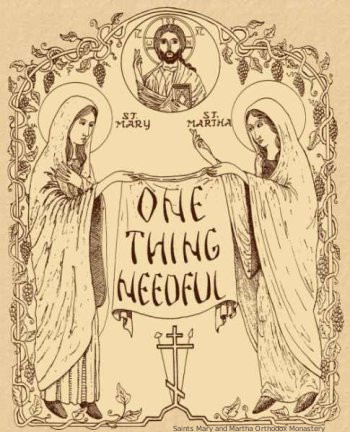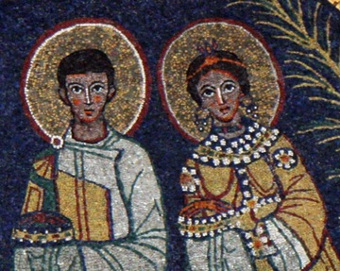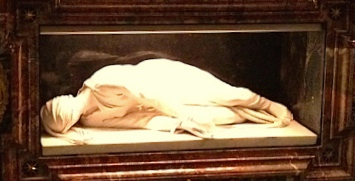
ONE THING NEEDFUL
FALL 2014 & WINTER 2015
Ye lusts, and have not: ye kill, and desire to have and cannot obtain: ye fight and war, yet ye have not, because ye ask not. Ye ask, and receive not, because ye ask amiss, that ye may consume it upon your lusts. — James 4:2-3
Often we limit the meaning of the word “lusts” to sexual desires and do not expand it to include all the sensual appetites/passions/sins. In so doing, we rob ourselves of perceiving a major part of our spiritual warfare — ourselves.
Our desires to fulfill the passions of this life, physically, mentally, emotionally, and spiritually, are usually excessive. Pride, self-justification, eating, drinking, laziness, busyness, emotional and intellectual gratification, etc., either without limits or with sever restraints, lead us to greater degrees of emptiness and eventual spiritual death. We find ourselves fighting to fill this void with the same actions, thinking that they will satisfy us, and, instead, find the void within growing. Thus, we often do not realize that the source of our distress is in desiring what we think is good for us. This is one of the faces of deception used by the evil one who would seek our utter destruction.
Therefore, we ask for what we think is good for us rather than asking God that His will be done, not ours. Our Father, who knows our path far better than we do, does not give us what we want. He does not want us to destroy ourselves with our “lusts” that lead to death. Rather He gives us what He knows will lead us to eternal life. These good things seem to us to be painful because they separate us from our destructive, but most sought after “lusts.”

MONASTERY NEWS
Hardly had the last issue of our newsletter gone to press when we hosted the Clergy Wives Retreat. Twelve women attended. For the second time, we celebrated Liturgy in our unfinished chapel. And, for the second time, Fr. Thomas Moore served Liturgy. The sisterhood that these women have formed and continue to form and their willingness to sleep wherever they can find a space here so that other clergy wives may join them uplifts the spirits and bears witness to the fact that there is always room at God’s table for one more.
As of our last report, we had received our order of standard red-blend brick. However, the cove and ogee brick took another nine weeks. It seems that since the downturn in the economy, the brick companies no longer keep speciality brick on the brickyard, even common colors like red-blend. So they had to be ordered from the only manufacturer in this part of the country. Our tiny order stood in line with no hope of being expedited. Once again, we had another exercise in patience and reminded ourselves that everything comes in God’s time, not ours.
Ever faithful, Mother Helena continues to make candles with the help of one of her God daughters. Our candle orders continue to increase. We have never been able to keep a stock of the thin tapers that are used in many churches. Thanks be to God.
On the second Saturday of October, Mother Thecla drove to Saint James Orthodox Church in Port St. Lucie, Florida, and gave three short talks on ”Life in Orthodoxy”. There were many questions and much sharing of personal experiences. It was wonderful to see the new church they had built and all the progress made over the last thirty years. May God bless them to continue to grow in His vineyard.
A group of women with their pastor visited us on October 21st from the United Methodist Church in Wagener. We had met some of them before and were delighted to visit with them and give them a tour of our monastery.
Julian Earle Griffin, Jr., a parishioner from Saint John of the Ladder Orthodox Church in Greenville, South Carolina, was buried here on October 31st. He is remembered as an eccentric Southern Gentleman.
Being blessed with a goodly number of items to sell in the Fall flea market and for the Saint Nicholas Festival, we spent time figuring what some things were worth and pricing everything. We rented four tables at the Barnyard Flea Market for November 22nd and brought seven foldout tables of our own. We were blessed with four volunteers. Otherwise, we could not have done this. It took all of us two hours to unpack everything and set it out, selling all the while. Some things were sold right out of the vehicles. After everything was unpacked, we looked at all the overloaded tables and realized why we felt like we had priced things till the world looked level. $563.76 was added to our Building Fund. This was our best flea market ever.

We packed away the flea market stuff and started preparing for Saint Nicholas Festival which actually fell on his feastday, December 6th. This year we finally found a local wooden toy maker and procured a number of his toys and added them to the many items we had to sell. We did well in spite of the intermittent rain. $1033.80 was raised for the Building Fund, mostly in jewelry and gift items. The day was successful for everyone.
Speaking of raising funds for the Monastery Building Fund, Beverly Dickey & Terri Geeza of Saint Mary of Egypt Orthodox Church in Norcross, Georgia have been busy selling jewelry as well.
So many of you are helping in whatever way you can. We are most grateful to you and to God who directs you.
Digressing slightly, on November 24th, we received word that the speciality bricks would be delivered the following week and the brick masons would be here the following Monday, December 8th. After months of waiting, all this information transpired in an hour. “Except the Lord build the house, they labor in vain that build it.” (Psalm 127:1) Believe it or not, the bricks arrived the week after Thanksgiving and the masons the following Monday.
When the brick masons arrived they asked, “Did the building grow since we last saw it?” They had remembered a smaller building.
As the pictures below show, they have completed two of the three tall walls, the east and the south walls.

Getting started
Digging down to
footers & laying
the first course of
bricks on the
South side

All in a
morning’s
work


Time to move around to the East side


Row, upon
row ,upon
row, until
we reach
the top

East side is finished.
The two pillars are to attach
the outside stairway.

Back to the South side

South side is finished.
The unfinished section
is the sun room.
It will be finished
after the North
wall is done.
These brick masons are truly artists as the brick work is first rate. These pictures do not do their work justice.
Very early Christmas morning, we woke up to a loud thud only to discover that Corelli, our tricolored collie, had died. Being twelve, he had been on large doses of pain medicine for profound hip dysplasia. His heart probably gave out. He was known for attending all the funerals, being very gentle with children, and keeping the coyotes away.

Earlier in December, six steel picnic tables and a matching garbage can were shipped to us. All of them were coated with dark blue, baked on enamel. Stephanie Douglass, a young friend, helped assemble them. They should last beyond our lifetimes.
Remember, God is truly good and cares for us all.

SAINT CECILIA
SAINTS VALERIAN, TIBURTIUS
& MAXIMUS
(November 22nd)*
When we think of Saint Cecilia, what do most of us know of her beyond that of being a virgin martyr of Rome in the early centuries of Christianity and the Patron Saint of Sacred Music, the Patron Saint of Musicians, and the Queen of Harmony?
This Saint Cecilia was martyred in the year 230 A.D. during the reign of Alexander Severus (222-235 A.D.) and should not be confused with other saints of the same name, two of whom were also virgin martyrs of Rome.
Four years before Alexander Severus became Emperor of Rome, his mother, Julia Mammaea, was residing in Antioch where, it is thought, that she embraced Christianity. She had Origin, a leading second century Christian theologian of Alexandria, Egypt, escorted to her domicile to converse at great length with him on Christian theology (as recorded by the pagan historian, Herodian). On March 13, 222, her twenty-one-year-old son, whose full name was Caesar Marcus Aurelius Severus Alexander Augustus, was made Emperor of Rome. While Alexander was opposed to violence, he was easily manipulated by his mother, his councilors, public opinion, and by contemporary historians who might record his reign unfavorably for posterity.
Cecilia hailed from an illustrious Roman family whose linage stretched back to the Etruscans through Cecilia Tanaquil (Etruscan: Thanchvil), wife to the fifth king of Rome, Lucius Tarquinius Priscus (616-579 B.C.) who was the son of an immigrant to Etruria. One of Saint Cecilia’s most famous and well loved ancestors was Cecilia Metella, daughter of Quintus Cecilius Metellus Creticus a Consul of the Roman Republic in 69 B.C., and wife of Marcus Licinius Crassus, a general and politician who played a major role in transforming the Roman Republic into the Roman Empire, amassed a great fortune, and was considered the wealthiest man in Rome. A grandiose mausoleum was built in memory of Cecilia Metella at the third mile marker on the Appian Way and stands to this day. Suffice it to say, numerous, highly influential people, both historical and legendary, formed the intellect and valor of Saint Cecilia.
Being born of pagan parents and growing up in ostentatious environs, Saint Cecilia was initiated into the mysteries of Christianity at a very young age, perhaps from infancy. Whether it was a close relative or her governess, we do not know. As she grew, so did her love and faith in Christ Jesus. She hid a book of the Gospels under her cloths and next to her heart. Fasted and prayed ardently. Eventually, she wore a hair shirt under her rich garments to help her overcome the passions of the flesh and, thereby, draw ever nearer to her Lord and Savior to Whom she secretly vowed perpetual virginity.
From 222 to 230 A.D., Urban I was Bishop (Pope) of Rome. Twice, he was summoned to the Praetorium where he openly confessed his faith in Jesus, each time expecting to be tortured and possibly martyred. After being released the second time and remembering that his predecessor, Callistus I, had suffered martyrdom at the beginning of Alexander Severus’s reign, he decided that it was no longer safe to live in the city limits of Rome and went into hiding in the catacombs at the third mile marker on the Appian Way.
Temples to the Roman gods and goddesses, aqueducts, and pagan graves and monuments crowded the landscape of the Appian Way for miles, as this was outside the city limits of Rome where people had been allowed to bury their dead since 500 B.C. By Saint Cecilia’s time, the Christians had endured over two centuries of persecution in Rome and had hollowed out underground passages and graves in the walls and buried many of their martyrs in these catacombs which laid beneath the pagan exterior. Within the labyrinth of this City of Martyrs resided numerous Christians who also had dug out living spaces and churches.
Cecilia was well known by these Christians for she often visited the tombs of her ancestors, particularly that of Cecilia Metella, without arousing the suspicions of the authorities. The Christians who lived there appreciated her magnanimity towards them. Often she met with Saint Urban for Christian instruction. If any message was sent from Cecilia to Urban, he was sure to receive it.
The time came when Cecilia’s parents arranged for her to marry Valerian, a young, handsome patrician of good character, but, nevertheless, a pagan. If Cecilia lobbied against this marriage or suffered in loud silence and prayed for God’s deliverance, her parents paid no heed. The marriage would take place according to the traditions and customs of pagan Rome. The two noble families would be united through the marriage of Valerian and Cecilia.
Desiring with all her heart to remain a virgin for Christ, Cecilia spent the time until her wedding day with fasting and arduous prayers to be delivered from this marriage. Nevertheless, her wedding day arrived, and Cecilia was compelled to adhere to the old Roman marriage rituals that were required of her patrician status. Cecilia was likely robed in a simple white woolen tunic and girdle as her Etruscan ancestor Cecilia Tanaquil had. Her hair was arranged in six tresses like the Vestal Virgins (a Roman custom permitted to brides). Saffron-colored shoes adorned her feet. A flame-colored veil (a symbol of faithfulness that originated from Flaminian women who were prohibited by law to divorce) covered her head. Both she and Valerian donned floral-herbal wreaths. Playing their instruments, musicians sang bawdy secular songs, but Cecilia, endured with composure and withdrew into her heart and sang Psalms to her Christian God and vehemently prayed for fortitude to face her husband.
After the sumptuous, wedding banquet, Cecilia was led into the lavishly prepared bridal chamber. When Valerian arrived shortly thereafter and the door was closed, Cecilia exacted a promise from him that he would not reveal the secret she was about to tell him. She informed him that she was watched over by a God appointed angel who was the protector of her virginity, and, that, if he should take her, he would fall victim to the angel’s vengeance. However, if he did not, he would find favor with her angel and receive love and blessings. Upon hearing this, Valerian asked to see this angel. Cecilia responded by stating that, if he wanted to see her angel, he would have to be purified in the waters of eternal life (baptism) and proceeded to instruct him in Christian beliefs. Valerian, desiring to see the angel and being persuaded that Christ’s teachings were good, obtained instructions from Cecilia on how to find Bishop Urban.
Well before dawn, Valerian was in the presence of Urban who was overjoyed that Cecilia had converted her husband to Christ. Urban turned to God in prayer. After praying at great length, a venerable old man in white garments appeared before them. It was Saint Paul, Apostle to the Gentiles, holding a book written in gold. Terrified, Valerian fell prostrate. Gently raising him up, Saint Paul opened the book and asked him to read, “One Lord, one faith, one baptism, one God and Father of all, who is above all, and through all, and in you all.” (Ephesians 4:5-6) Then the Apostle Paul asked if he believed this. To which Valerian said, “Yes.” When the august elder finished speaking, he disappeared, leaving Urban to baptize Valerian.
Valerian returned home rejoicing and wearing the new, white garment of one recently baptized. (Seeing people in new, white garments was a common sight on the streets of Rome since many religious sects of the day robed their initiates in this manner.) There he found Cecilia in prayer with her angel beside her. In the angel’s hands were two heavenly crowns interwoven with never fading roses and lilies. He placed one on Cecilia’s head and the other on Valerian’s. This heavenly messenger explained that these crowns were bestowed on them as a reward for preserving their virginal purity and could only be seen by those whom the Holy Spirit allowed.
Turning to Valerian, the angel stated that Christ God, who had sent him, would honor any request he made. Overcome with gratitude, Valerian prostrated himself and asked that his brother, Tiburtius, would be delivered from the delusions of this world as he had been, receive baptism, and perfect both of them in their confession of Christ. To this the angel replied that his request had found great favor with Christ, that his brother would believe and be baptized, and that both of them would receive the palm of martyrdom. (In Christianity, a palm symbolizes victory over the evil one.)
After hours of Valerian and Cecilia immersing themselves in the salvific teachings of Christ, an impatient Tiburtius burst into the bridal chamber. Giving Cecilia a fraternal kiss on her forehead, he smelled, but did not see, the crowns of roses and lilies. Tiburtius expressed great amazement at this overwhelming, out-of-season fragrance. Seizing the moment, Valerian joyfully shared all that had happened to him. Cecilia remained silent until Valerian’s exuberance abated enough for her, who had been a Christian for most her life, to instruct both brothers in Christian theology and refute pagan philosophy. Taking their leave of Cecilia, Valerian and Tiburtius directed their feet towards the third mile marker on the Appian Way where they found Bishop Urban, who, having asked Tiburtius about his faith in Christ, baptized him.

Saints Valerian & Cecilia
9th Century Mosaic
at Santa Cecilia in Trastevere
In the Spring of 230 A.D., Alexander Severus readied his army to leave on a military campaign against the Persians. Turcius Almachius, Prefect of Rome (Civil Magistrate), who, like many Romans, despised the Christians, but, veiling his hatred for this odious sect, strove to remain in political favor with the Emperor. Knowing that the edicts against the Christians were still in place and that Severus would never openly support the Christians, Almachius had great numbers of Christians of the plebeian class arrested, tortured unmercifully, and ordered their bodies left unburied. Realizing that, if caught, they also would become martyrs, many Christians secretly gathered the bodies of the martyrs or obtained their bodies through bribes so as to provided them with a Christian burial.
Using their wealth, Valerian and Tiburtius zealously gathered the bodies of the martyrs, buried them, and helped the bereaved families. Soon, they were denounced and arrested. Not wanting to torture or execute anyone of the patrician class, Turcius Almachius sought to avoid passing sentence on Valerian and Tiburtius, but to no avail. After much dialogue with the Prefect as to why they were Christians and discovering that the brothers would not deny Christ, Almachius ordered that Valerian be stripped and scourged with rods while a herald announced his crime, “Beware of blaspheming the gods and goddesses.” Valerian used this opportunity to preach Christ to the crowd. Realizing that Almachius was still endeavoring to extricate himself from the situation, Tarquinius, the Prefect’s assessor, whispered to him that if he waited, they would apportion all their wealth, and the state would have nothing to confiscate. Immediately, Almachius sentenced them to be escorted to the Pagus Triopius near the fourth mile marked on the Appian Way, to be given a final chance to offer incense to the gods, and, if they refused, to be beheaded.
Maximus, the Prefect’s notary, was selected to accompany the two patricians to the place of execution and to record it. As they walked, Maximus observed the joy, love, and peace that the brothers possessed and began to ask questions. Filled with the Holy Spirit, Tiburtius and Valerian shared with him the salvation Christ offers to all mankind. When Maximus expressed his belief in Jesus and his desire to be numbered among His followers, the brothers asked that he persuade the soldiers and executioners to delay their beheading for a day, to which they agreed. Proceeding to Maximus’ home, the brothers continued witnessing to him, his family, and those present. Somehow word of this matter was sent to Cecilia. Knowing what to do, she entered their abode at nightfall with some priests who baptized Maximus and his whole family and some of the soldiers.
With the rising of the sun, Valerian and Tiburtius were led through the vast cemetery along the Appian Way to the appointed place of their execution. Even though the newly baptized Christian soldiers could not behead the brothers, the pagan soldiers were able to carry out the Prefect’s command. Maximus was blessed to see angels ushering their souls to heaven.
Infuriated, Almachius order Maximus to be beaten with a loaded whip until dead. Cecilia herself buried his body in the catacombs near those of her husband and brother-in-law.
Meanwhile, Almachius issued a mandate that all of Valerian and Tiburtius’ property be confiscated as prescribed by Roman law. A search was made, but nothing was found, for Cecilia had astutely dispersed everything to the poor. Outmaneuvered, the Prefect was incensed.
Realizing that he was confronted with a well known noble woman who was unlawfully a Christian and not wanting publicity that would demean his position, Almachius sent court officials to her residence with the proposal that, if she complied with the law and privately offered incense to the Roman gods, she would not be exposed to a public trial. With heavenly calmness, she eloquently expounded on the impiety of the Prefect and why she would sacrifice everything, including her life, for her beloved Christ. Hearing the report from his officials, Almachius delayed summoning her before his tribunal.
Word of what was occurring circulated rapidly. Being profoundly impressed with her words that taught them the saving grace of Christ, over four hundred were converted to Christ. Saint Urban I secretly arrived at Cecilia’s home and sequestered himself there. With great joy, he baptized many. Utilizing this delay, Cecilia signed over her mansion to Gordian, a Christian, with the stipulation that it become a Church.
Soon, Cecilia was summoned to appear before the Prefect Almachius. Being intimidated by her great nobility, he feigned not to recognize her social status and began the court proceedings. His interrogation of her only substantiated her resolute faith in Christ and provided her a venue to make counter arguments against the pagan ways of Rome. Not wanting to execute Cecilia publicly, Almachius ordered that she be escorted back to her home and confined to the caldarium (sauna). Then they were to heat the water so that the intensity of the steam suffocated her. Joyfully, Cecilia entered the caldarium, remained there for hours, and emerged unharmed.
Report of this proved most disconcerting to Almachius. Seeing no alternative, he dispatched a lictor to behead her. After three unsuccessful attempts, as the law allowed no more, the lictor withdrew in terror leaving Cecilia lying on the floor near the caldarium. The faithful entered the room to find Cecilia in great pain, but with the joy that passes all understanding written on her face. For three days she lay there while they collected her blood in linen cloths. It was her prayer to be given three days to bear further witness to Christ and to finish setting her affairs in order. Bishop Urban emerged from his hiding place within her mansion to bless her and to learn that she had given her great house to be converted into a church.
Saint Cecilia died lying on her right side with her face to the floor, her right hand showing three fingers for the Trinity and her left one finger for Their unity (Three in One). Saint Urban (May 25), who himself was martyred about a month later, laid Cecilia’s body in a cypress coffin and buried it in the catacombs in the Cemetery of Sixtus along the Appian Way.

As Seen by the Carver Stefano Maderno in 1599
Commissioned by Cardinal Paolo Emilio Sfondrati
In 821, Paschal I received a vision in which Saint Cecilia revealed her burial place to him. She was found to be incorrupt and, leaving her body whole (i.e., not taking any relics), reinterred her below the principal altar of her Basilica, Santa Cecilia in Trastevere, which had been her home five centuries earlier. In 1599, Cardinal Paolo Emilio Sfondrati exhumed her body, found it incorrupt, translated her body with the cypress coffin into a magnificent casket, and, also leaving her body whole, reinterred her in her Basilica.
God has worked and continues to work countless miracles through Saint Cecilia.
*Although these four saints were martyred on different days, the Orthodox Church remembers them on November 22nd.
Life of Saint Cecilia Virgin and Martyr, by Reverend Prosper Guéranger, Abbé de Solesmes, Translated from the French, Peter F. Cunningham, Philadelphia, 1866
The Lives of the Holy Women Martyrs: An Orthodox Martyrologion of Spiritual Heroines, (pgs.480-490) Translated from the Greek, Holy Apostles Convent, Bueno Vista, Colorado, 1991

BUILDING FUND UPDATE
As always, God is so very good. The brick is being laid. The last section of the roof is installed. Except for the exterior stairwell, everything else needed to dry-in this part of the building will probably be done by the time you read this.
We know that we are a “link in the chain” of Christian monastic history and are building this monastery for those who will come after us. Otherwise, God would not have allowed us to come this far.
MATCHING FUNDS CHALLENGE
A friend of the monastery has put up $2000 to match dollar for dollar any donation to the building fund. This offer is good until Pascha (Easter) on April 12, 2015, and is in memory of Mother Lyubov.
Saints Mary & Martha Orthodox Monastery
65 Spinner Lane
Wagener, South Carolina 29164



Saturday Liturgy Schedule
February 14th at 9am
March 7th at 9am
April 25th at 9 am - Pilgrimage
May 16th at 9am
June 6th at 9am
Matins starts at 8 am.
*Saturday Liturgy will probably be May 16th
as May 8th - 9th is tentatively set for the
Reinterment of Archbishop Dmitri &
the Installation of a new Bishop for the
Dioceses of the South.
Knitters Retreat
February 6th & 7th
Contact Maria Floyd: 803-599-4404
OR e-mail her at mariajfloyd@gmail.com
This retreat is for women 21 years of age and older.
Due to limited space, we can only
accommodate twelve women.
You need to have a project or projects
that you can work on
without help from other knitters.

FROM MARTHA’S KITCHEN
Breakfast Treat
French Pancake
½ cup milk
2 eggs
1 cup flour
pinch of salt
Heat oven to 350° F.
Whisk together.
Melt ½ bar butter in a 9”x13” Pyrex dish. Pour the mixture over the melted butter and bake 25 minutes till golden brown.
Serve with powder sugar sprinkled over it and syrup or fresh fruit.
by Tatiana Gregory
of Blessed Memory
Greek Antidoron Bread
or
Really Good White Bread
- Put 2 packages of Red Star Quick Rise Yeast into one cup of warm water and add ½ cup sugar stirring.
- Place in warm place to activate while you put 5 pounds of bread flour into a large bowl (or pot).
- Add 2 tablespoons of salt - stir and make a well in the middle.
- Pour the yeast mixture into the well and stir.
- Slowly add 5 more cups of water to flour mixture until all is mixed.
- Knead dough for about 10 minutes.
- Let rise until at least double.
- Form 4 loaves. (I do rounds and put in “layer cake pans” with baking paper in them.)
- Place in cold oven and set temperature at 350° F. and bake for 45 minutes.